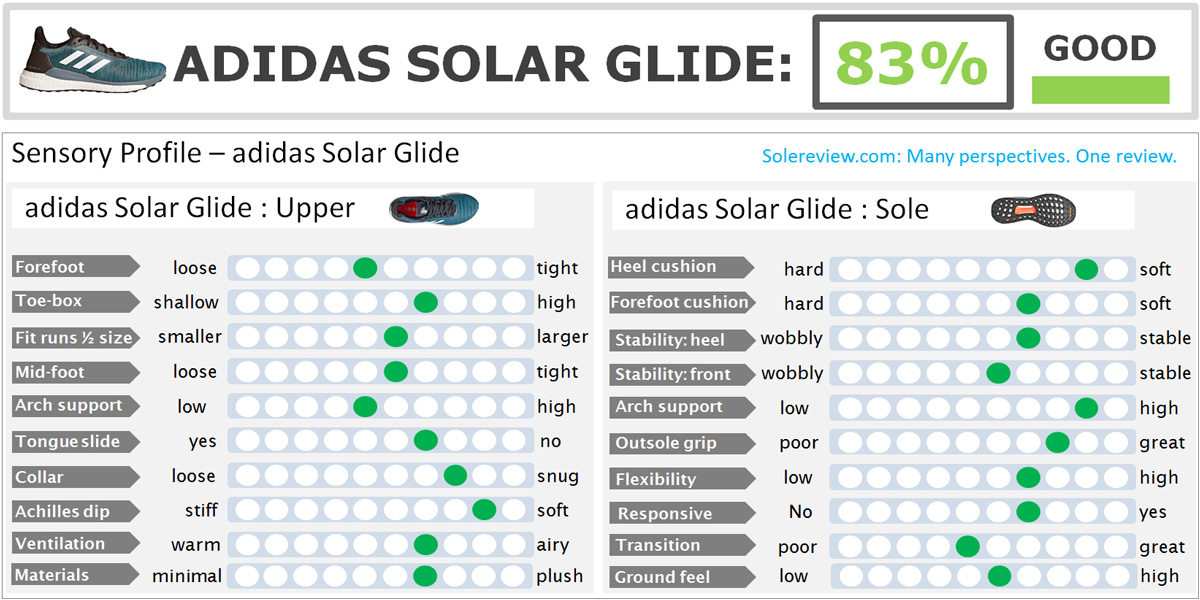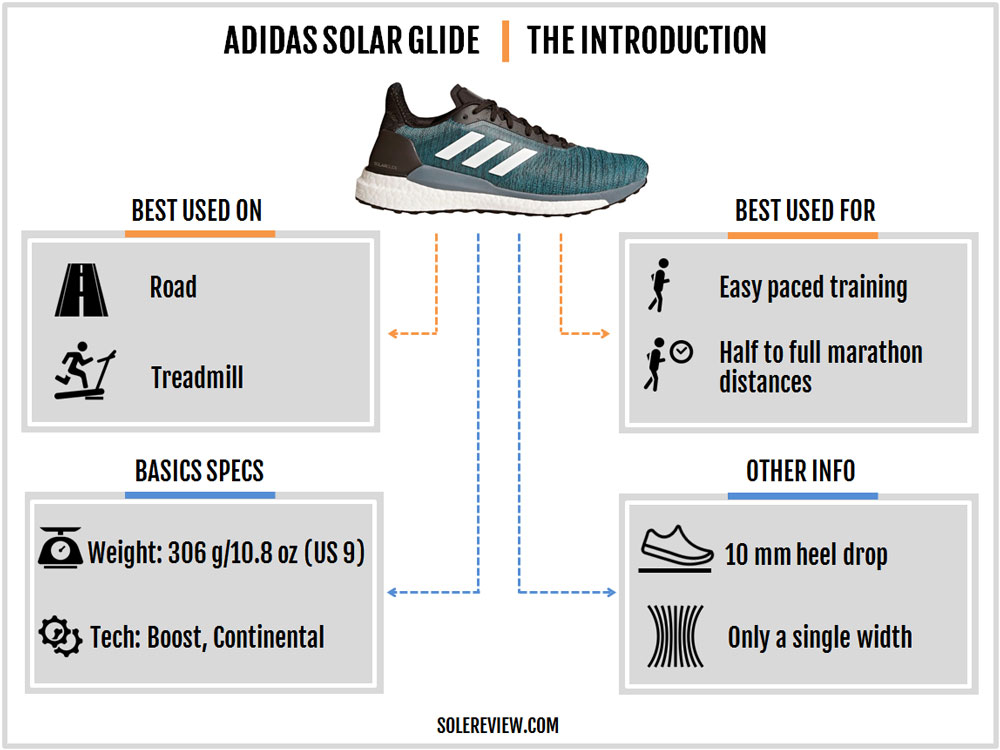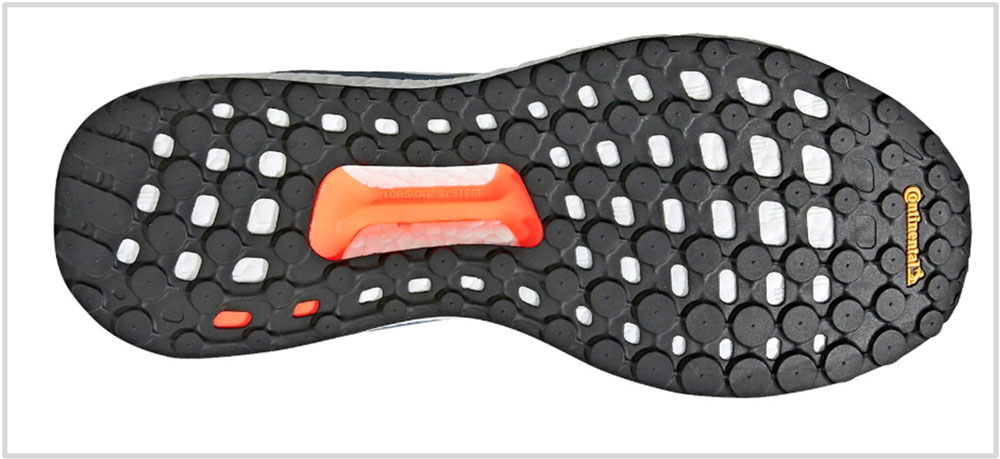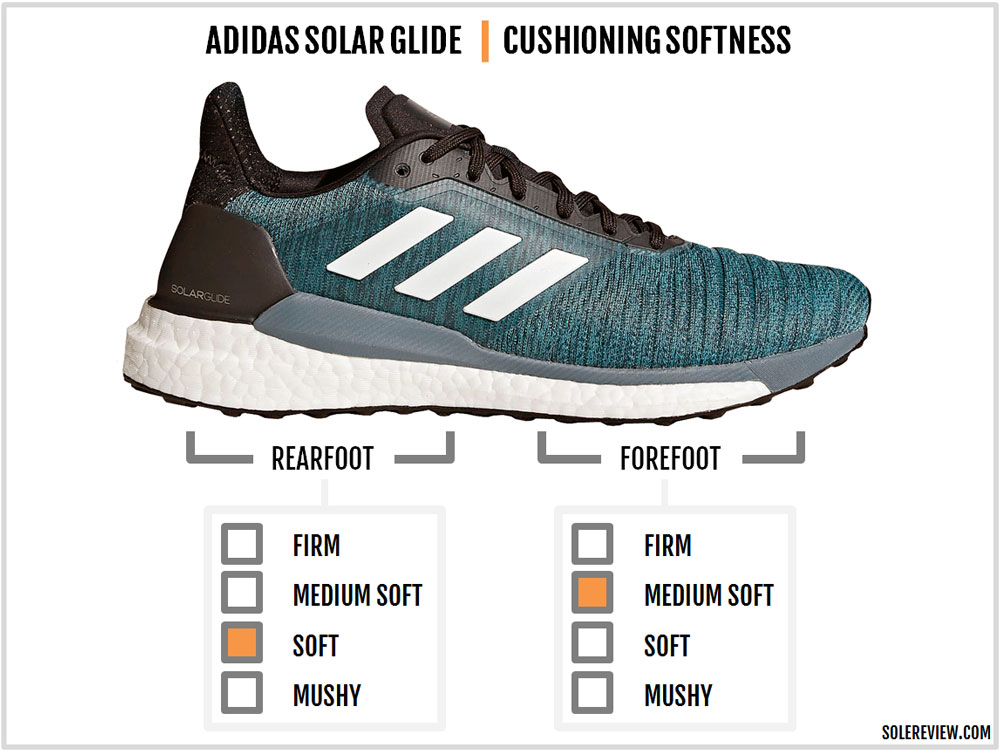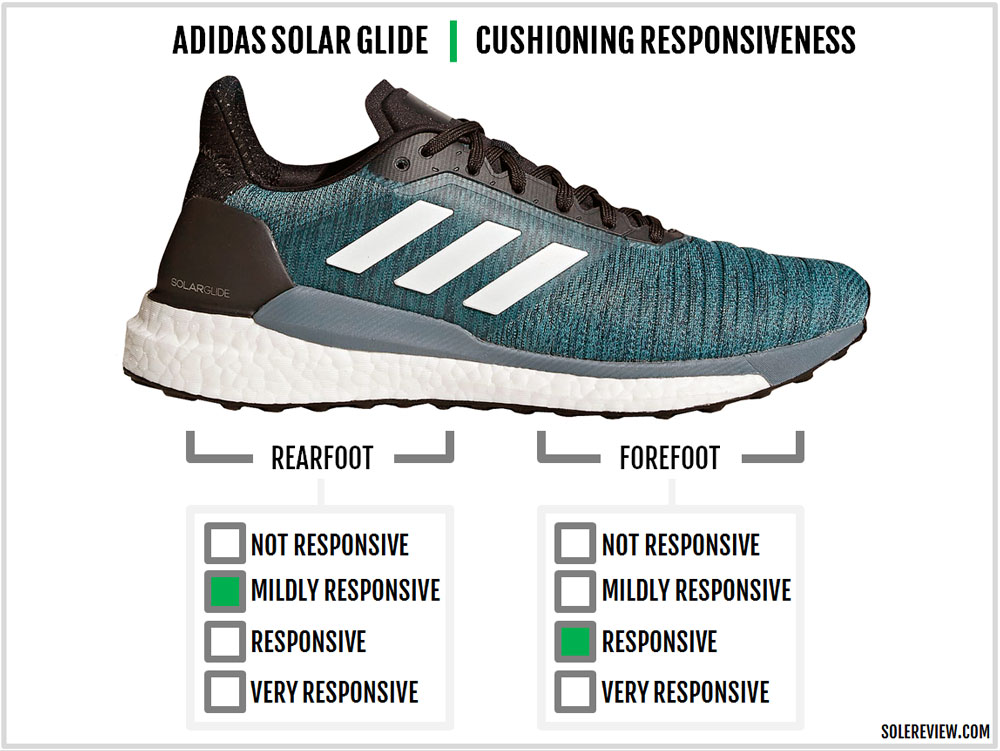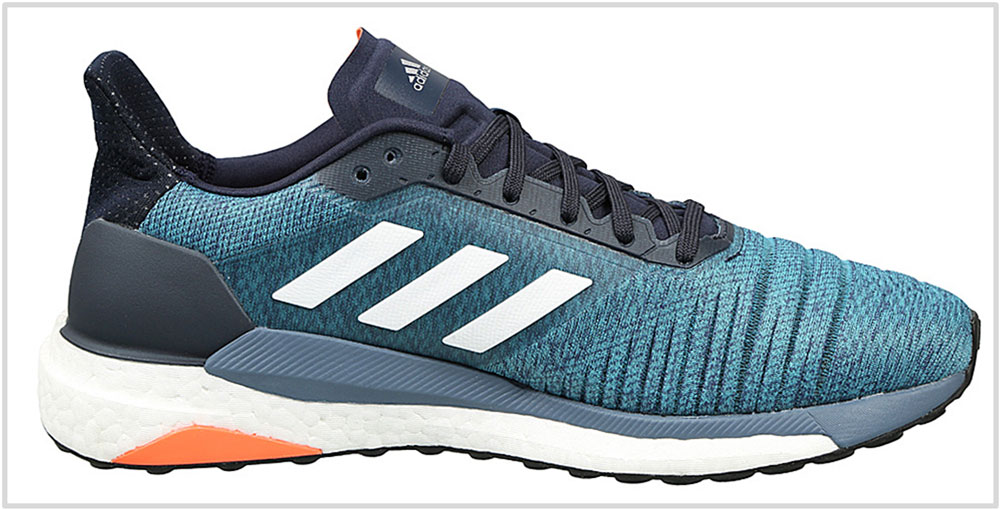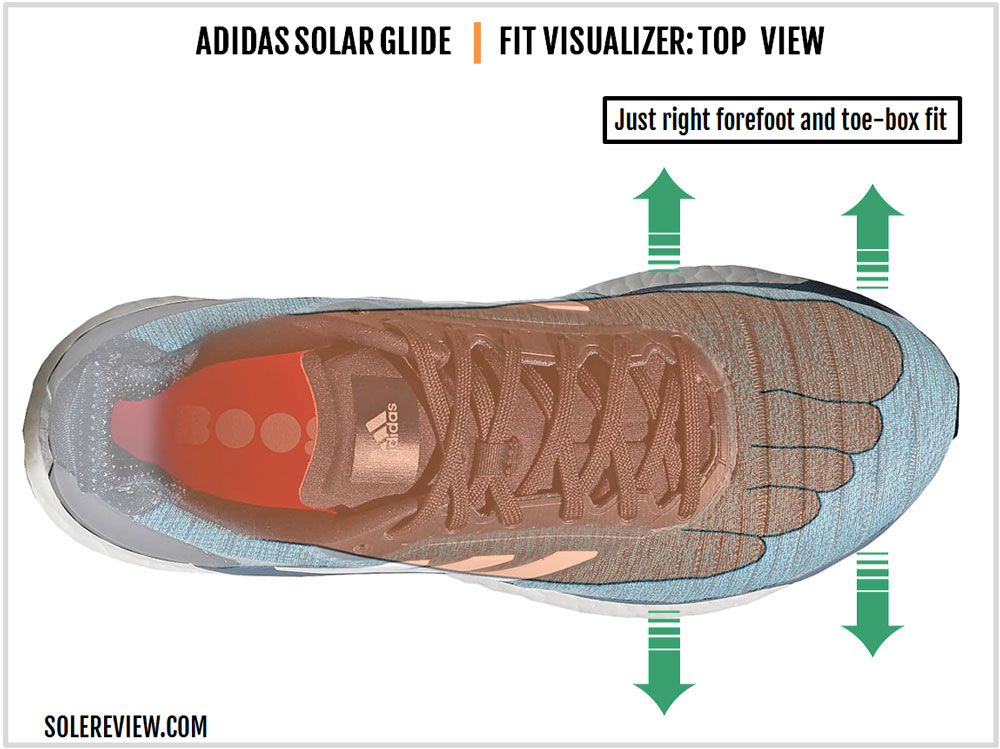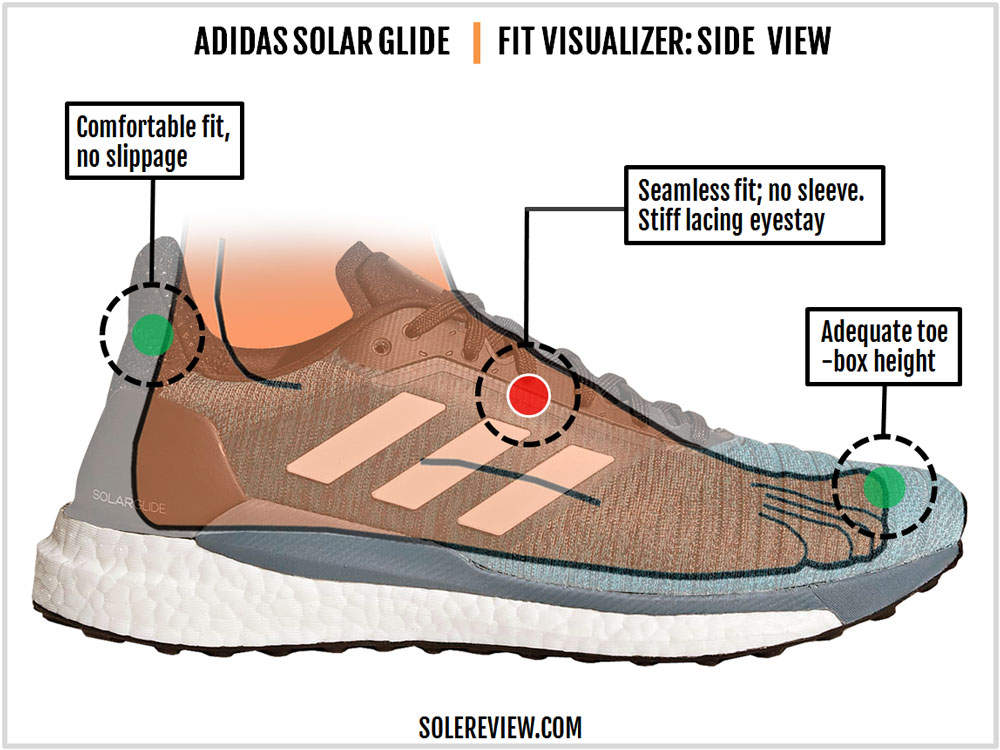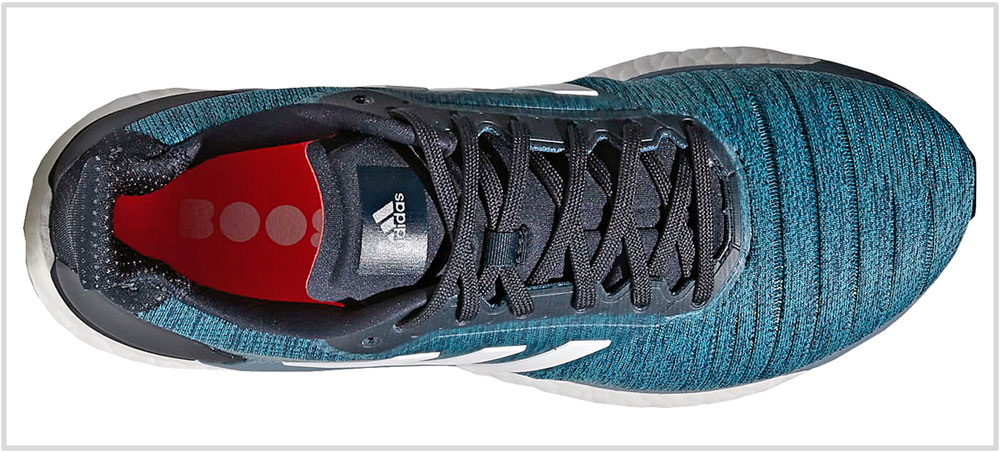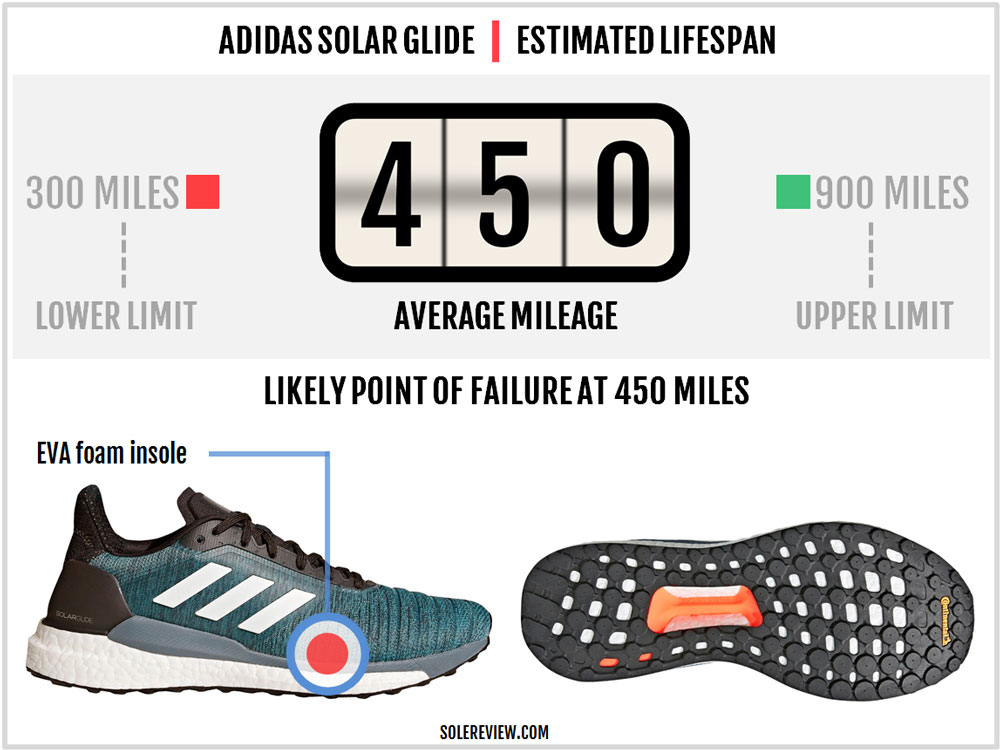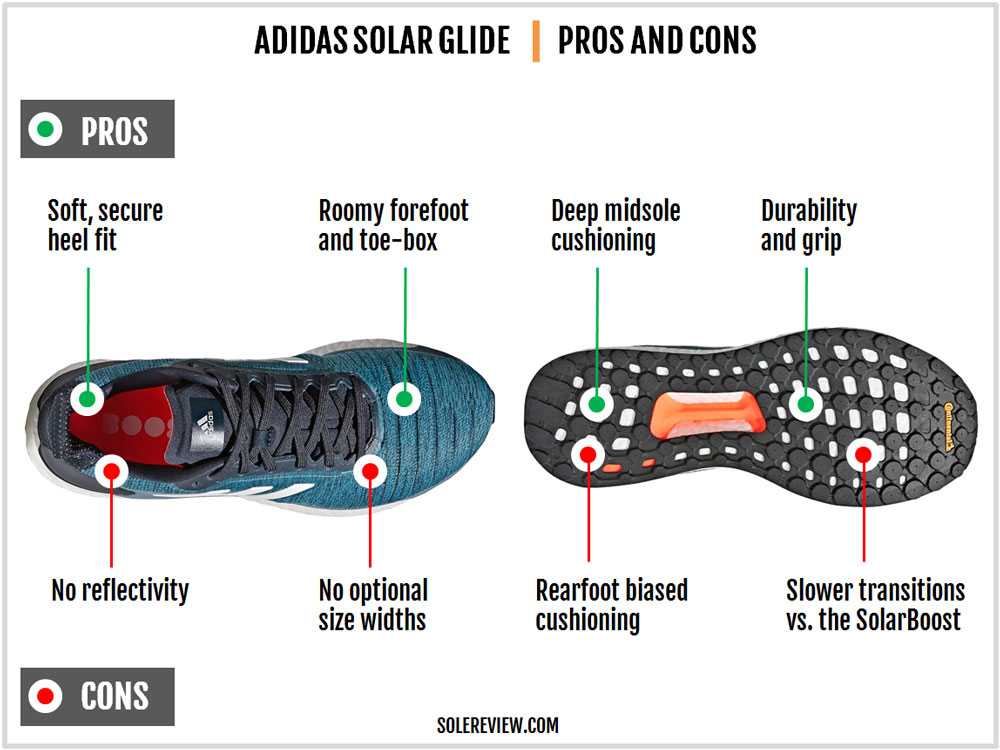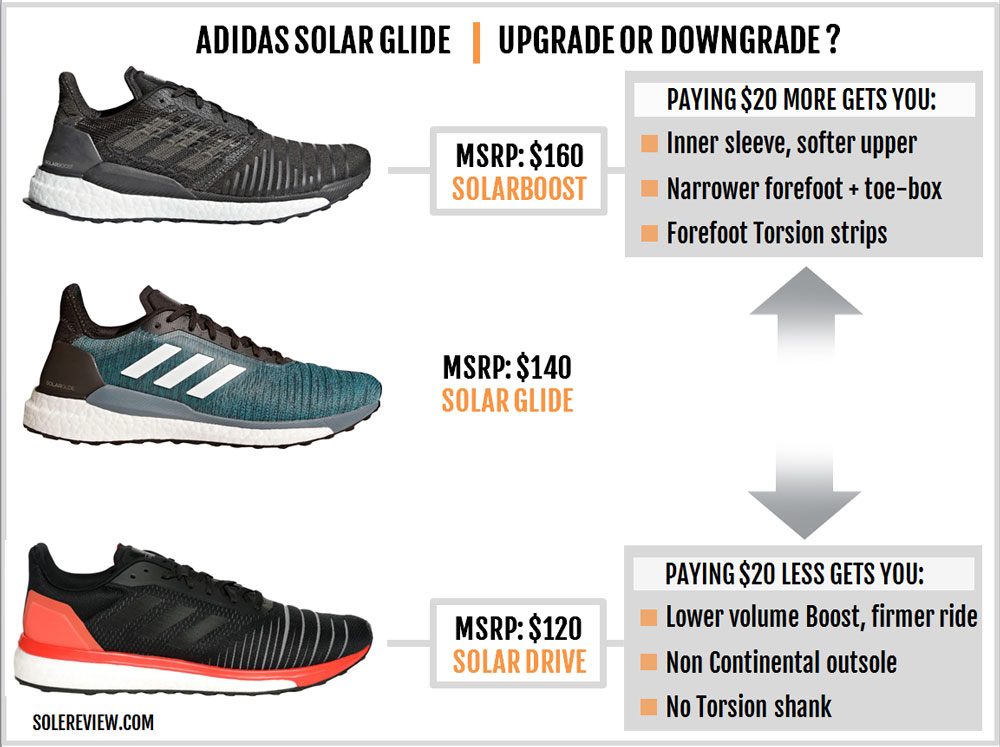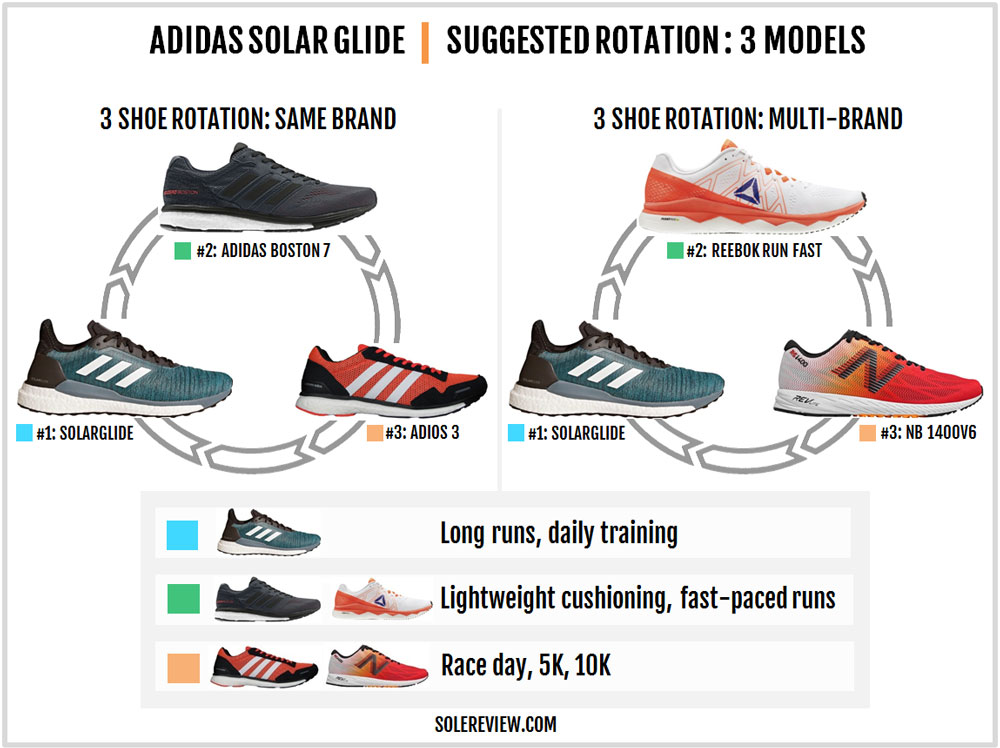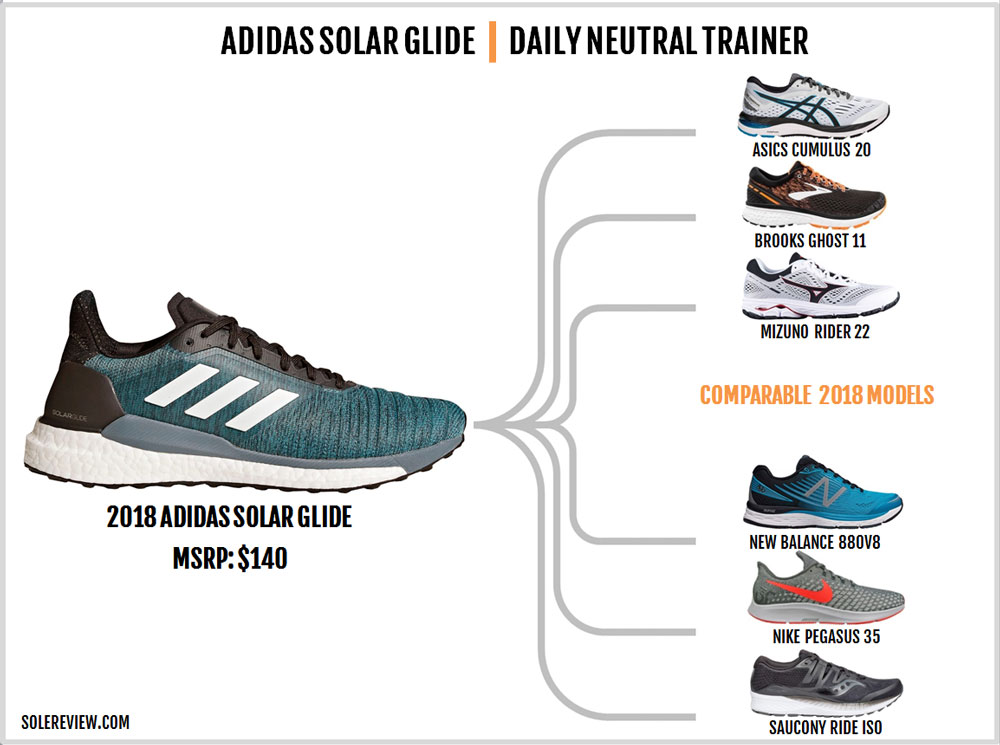INTRODUCTION
The 2018 adidas Solar Glide succeeds the 2017 Supernova, a neutral trainer with a soft ride. We’ve covered the details about the new ‘Solar’ nomenclature and categorization in our review of the SolarBoost, so we won’t repeat it here.
However, we’ll re-emphasize one thing – is the Solar Glide similar to the Supernova Glide 6-8?
No. The Solar Glide is rather a replacement for the softer Supernova we reviewed last year. In other words, the heel is softly cushioned with the overall midsole and outsole design following a similar template.
The upper fit is an improvement. There’s more space inside the forefoot and the toe-box. The materials and construction of the Solar Glide lead to softer interiors and a fit quality which is more easygoing than the Supernova. The new shoe is also marginally firmer to run in.
This update can mean different things to different people. If you liked the last year’s Supernova, then the Solar Glide is a worthy replacement.
The Solar Glide is also a suitable substitute for the SolarBoost, just in case you found the latter’s fit to be tight and also wanted to save some cash in the process. Except for the snappier forefoot, the ride is nearly identical for both models, so let the quality of upper fit drive your purchase decision.
On the other hand, if you’re looking for the ride character of the older-gen Supernova Glide Boost, then the Solar Drive or the Boston 7 are better alternatives.
At $140 US retail, the Solar Glide isn’t great value though. After the price jump, the Solar Glide costs $10 more than the shoe it succeeds.
At the bottom of this review, we’ve listed competing neutral shoes the Glide goes up against. Most of them are excellent products, featuring cushioning and upper technologies comparable to the Boost.
The $140 tag is worth it if you really, really love the soft Boost cushioning. Else, there’s the more affordable Solar Drive or equally great shoes from Brooks, Nike, and Saucony.
There was a time when Boost could command a price premium, those days are long gone. The standard for modern athletic footwear is a fast-moving goalpost, something which adidas seems to have lost sight of.
THE RIDE EXPERIENCE
The Solar Glide’s ride behavior is similar to the Supernova (Glide 9) yet not identical. A similarity is found in the manner how the heel compresses; the upper heel clip is mounted directly over the Boost midsole so all the cushioning softness is readily accessible on footstrike.
That said, the ride is slightly firmer than the 2017 Supernova – particularly under the inner heel. While the outsole of both the models has a similar looking layout and material (Continental rubber), the Solar Glide closes some of the exposed windows under the inner heel.
The now solid part of the outsole adds a bit of firmness and also makes the transitions smoother than the 2017 Supernova. Even the Torsion shank is larger on the Solar Glide, thus increasing the structural rigidity of the midfoot.
The combined updates (the outsole and larger Torsion) help rearfoot strikers progress more efficiently during the gait cycle.
The second reason for the firmer ride is the new midsole rim. The firm EVA top layer covers more sidewall than the Supernova 9 and this decreases the softness by a tiny margin.
The Solar Glide’s ride is still very soft. If there was an imaginary slider with the Supernova 9 at one end and the Supernova 8 on the other, the Solar Glide’s position will be a lot closer to the 9 than the 8.
The volume of the Boost foam used on the Solar is a lot more than the Glide 8, and besides, the Glide 8’s EVA rim wasn’t just that. The said part separated the foot from the soft Boost midsole, thus adding more support and responsiveness in the process.
The Solar Glide has a latticed lasting under a thickly molded insole. These components add softness to what is already a cushioned platform. The Stretchweb outsole geometry flexes along with the midsole and delivers a relatively soft and smooth ground contact.
Forefoot strikers will discover that the Solar Glide’s forefoot has softened in comparison to the Supernova 9. There’s a larger section of Boost foam left uncovered on the sides.
Versatility is the casualty of the cushioning softness. The Solar Glide – and for that matter, the SolarBoost – aren’t shoes you’ll feel confident wearing during faster runs. While we agree that not all soft shoes are unsuitable for speed-work, those are exceptions than the norm.
Things go well when you’re out on your easygoing daily run, say, at speeds of 10 min/mile, 6 min/km or slower. The Glide also feels at home when you’re in for the long haul. If you’re running a marathon, you’ll certainly be thankful for the comfort drawn from the deep reservoir of Boost cushioning.
The ride has a neutral quality with very little bias. Even with all the softness, the Glide’s support level isn’t bad at all. Besides the ridged construction of the midsole sidewall, you have the wide outsole footprint, the medial post, and the raised EVA rims helping make the shoe supportive.
The traction from the Continental rubber outsole is superb on the road, be it under wet or dry conditions. The Boost foam is also highly resistant to temperature changes (say freezing winters), so the shoe excels at maintaining its cushioning consistency.
However, once you quicken the pace, the realization slowly dawns that you should have picked something more appropriate out of your toolbox. A shoe which feels like less work, and without the super-soft to medium-soft transition going on.
The reason why we reviewed all three Solar models together was to determine how close or far they were to one another. The conclusion? Despite plenty of common design elements tying them together, a few things were unexpected.
The first finding was that the SolarBoost’s forefoot feels snappier than the Solar Glide and Drive. Turn the shoe over, and you’ll understand why.
On the SolarBoost, the midfoot plastic Torsion extends its ‘fingers’ under the forefoot sides. This adds stiffness to the forefoot which proves useful during transitions and toe-offs. The SolarBoost feels noticeably snappy under the forefoot than the other two.
The second finding was the Solar Drive’s rearfoot feels more responsive than the SolarBoost and the Solar Glide. This occurs because the Drive’s Boost midsole is overlaid with an additional sheet of firm EVA.
This increases the responsive spring-back feel due to the improved ‘piston’ effect. The Drive’s lower stack heights also help; the midsole is 2 mm lower than the Glide and SolarBoost.
The adidas Solar Glide is a great pick if you all what you need is plenty of soft cushioning and a spacious upper to see you through the long miles.
At the same time, the Solar Glide lacks the Swiss-army knife versatility of the older Supernova or even contemporaries like the Nike Pegasus 35 or the Saucony Ride ISO. As long as you manage your expectations, the Solar Glide will keep you happy.
UPPER FIT QUALITY
The first thing which most runners will notice about the Solar Glide is the sheer amount of interior space. And by this, we don’t mean a baggy or a sloppy fit.
It’s rather the much-needed and just-right upper room which leads to improved comfort. This is of particular significance considering adidas doesn’t offer widths. Don’t ask us why though – we’re simply the messengers.
A couple of factors influence the upper fit. The first is the use of an upper mesh which is not only soft to the touch but also does a better job at accommodating foot splay. The mesh architecture incorporates open areas or ribs which helps with elasticity and ventilation.
The toe-box isn’t pointy or shallow. In fact, the internal bumper equipped upper is quite broad near the tip, thus creating optimal space – both sideways and vertically.
The sizing fits true, and the forefoot will even fit runners who usually opt for a 2E (wide). The forefoot space is at par with the Nike Pegasus 35 and roomier than the likes of the Saucony Ride or the Brooks Ghost.
Getting rid of the 2017 Supernova’s plastic midfoot overlay improves the fit quality by a great deal. Sure, the Solar Glide uses stiff urethane panels but they differ from the Supernova due to their thinness and placement.
The urethane panels angle away from the forefoot, and by doing so they do not hug the midfoot directly. So there’re no hot spots or ‘press in’ sensation over the foot.
Nonetheless, the panels tend to make the upper stiff – particularly where the lacing eyestay is located. The entire panel is nothing more than an extension of the urethane panel. When combined with the upper material, the eyelets feel stiff. Getting used to the last couple of stiff eyelets takes some time to break in.
The midfoot and lacing design reminds us of the Supernova Sequence 9, a shoe with similar break-in requirements. We’d rather prefer the pliable synthetic midfoot panel of the Glide 8 over the stiff urethane construction.
There’s no sleeve inside the Glide. To make amends, the tongue uses an off-center lace loop which arrests the slide. It works really well at keeping the tongue centered.
But if you really want an inner sleeve, the ST version of the Glide has one. Considering that the ST isn’t all that different from the Glide in the way it rides, you could buy the ST for a $10 extra. (The ST retails at $150)
The heel fit is just as comfortable as the SolarBoost. Like the more expensive model, the Glide does not use a hard counter. The plastic clip gives you all the support one needs without any discomfort. The collar ‘lip’ is gentle on the Achilles, and the lack of an internal stiffener helps the inner heel cup gently around the back.
Our verdict is that most runners will appreciate the Solar Glide’s upper fit. The additional room is welcome, the heel fits great, and the ventilation is taken care of.
We found a certain aspect of the Solar Glide and Drive’s upper design a bit odd. Let’s see if we can do a good job explaining this in words.
On the Solar Glide and Drive, the different components do not feel like they belong to a single shoe. For example, the tongue used is a soft, thin kind with molded foam quilting. That contrasts with the over-engineered midfoot and lacing eyestay. The same goes for the forefoot vs the midfoot and the heel.
The overlay-free forefoot, the midfoot, the tongue, and the Ultra Boost inspired heel clip felt like they were parts Frankenstein-ed from different shoes. The upper lacks a design, construction, or material flow which allows the shoe to act as one cohesive product.
One doesn’t get this feeling when running in the adios 3, the Boston, or the older Supernova Glides.
Even the Solar Glide ST does a better job at this than its neutral counterpart. Even though the ST version is supposedly a stability shoe, the midfoot does not use stiff urethane.
The ST’s midfoot panels are made of a more flexible synthetic suede, and there’s even a sleeve inside. The medial toe-cap on the ST ties in perfectly with the midfoot design, though it comes at the cost of a slight toe-box shallowness.
DURABILITY ASSESSMENT
The Solar Glide has the Boost+Continental package which is one of the best combinations for long-term durability. Expect the shoe to last just shy of 500 miles.
Even though the insole is EVA foam based and will undergo a gradual flattening process, there’s enough Boost foam underneath to keep the shoe cushioned. The layered upper should last the life of the shoe.
PROS AND CONS
The Solar Glide fits the description of a cushioned daily trainer perfectly well. The midsole has tons of Boost cushioning, though most of it is heel loaded. The upper has a spacious fit which breathes very well, so the lack of widths isn’t a serious problem. The heel fits great while delivering all-around comfort.
You pay more for the Glide this year. That said, the Boost and Continental outsole combine to deliver a durable running shoe with excellent road grip, so in a way, you get more dollar per shoe over the ownership period.
At the same time, things like the stiff midfoot and eyestay panels are the obvious gaps between being good and great. The Solar Glide could be less expensive as well – it costs $140 at full US retail and that’s above the industry median.
PRICE ALTERNATIVES
The SolarBoost costs $20 more than the Glide. The price difference gets you a smoother, sleeved upper with a tighter forefoot and toe-box. The ride is nearly identical except for the forefoot.
The Torsion shank on the SolarBoost extends into the forefoot; the Glide doesn’t have this. As a result, the Glide feels lazier under the forefoot than the SolarBoost.
For the same but downwards price difference, the Solar Drive combines a non-Continental outsole with a Boost midsole. Although the midsole lacks a Torsion shank, the ride is noticeably firmer under the heel than the SolarBoost and Glide.
That’s because the separate EVA foam layer is stacked over a lower height (- 2 mm) Boost midsole. The Drive’s upper has a regular fit and is not as tight as the SolarBoost. The Drive has plenty of reflectivity if that’s something which matters to you.
RECOMMENDED ROTATION
Except for the forefoot, the Glide rides similarly to the SolarBoost. So you’ll see the same rotation recommendations here – so feel free to skip this if you’re coming here from the SB review.
The Glide makes for an excellent daily trainer and marathon shoe if you want soft cushioning and spacious interiors. For faster training runs, the Boston 7 or the Reebok Floatride Run Fast work very well.
The adios 3 or the 1400V6 are great products to own if you plan to road race. Both these models have enough padding for at least 10k’s, and their lightweight profile helps speed up those short 5K bursts.
OTHER NEUTRAL CUSHIONED SHOES
This chart tells you that the Solar Glide costs around $20 more than the median price of competing neutral trainers. Let’s take the Ghost 11 for instance. Even with a brand new midsole made partially of the rubbery ‘DNA Loft’ foam, Brooks maintains its pricing.
For twenty dollar less than the Glide, the Ghost 11 is a formidable competitor. The upper interiors have a very smooth feel and the Ghost is available in four widths, no less.
Even the Nike Pegasus 35 is priced the same as the Ghost. It’s got a full-length Zoom Air cushioning and a super comfortable upper with optional widths. The Saucony Ride ISO is another competent do-it-all neutral trainer.
If you want something firmer, then the Asics Cumulus 20 and the Mizuno Wave Rider 22 are the shoes for you. Again, both of these are $20 less expensive than the Solar Glide.
The New Balance 880V8 comes loaded with old-school traditionalism. The heel biased cushioning is part of its supportive dual-density midsole with a plastic shank.
Even though the adidas Solar Glide ST is perceived as a ‘support’ shoe, it’s very similar to the regular Glide. The stability aspect isn’t overdone so the ride has a lot of neutral-ness in it. If you’re missing the inner sleeve on the Glide’s upper, then the ST is a good substitute for $10 more.
| Do you own this shoe? Improve this review by sharing your insights – submit a review here. |

